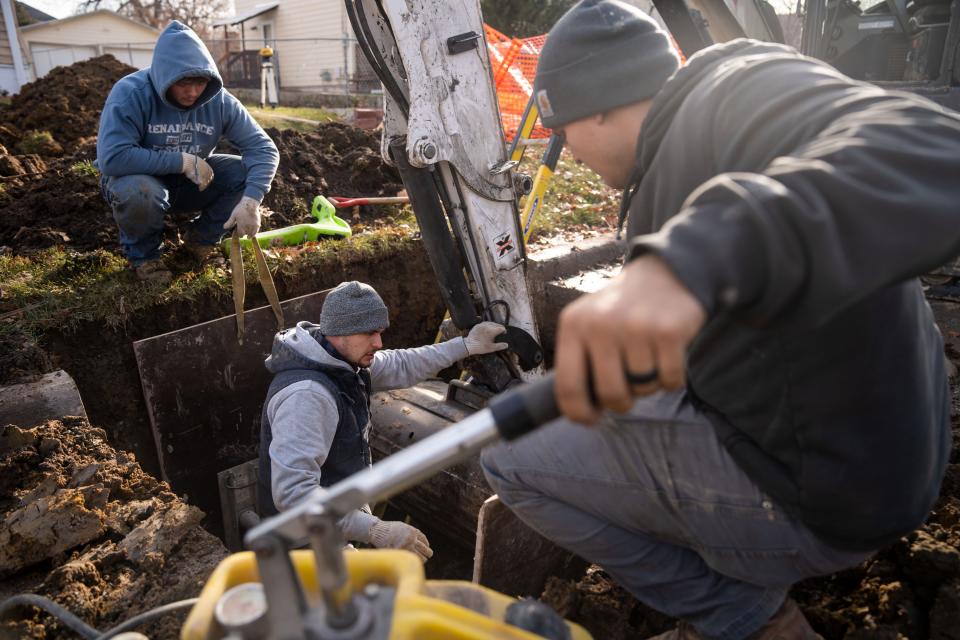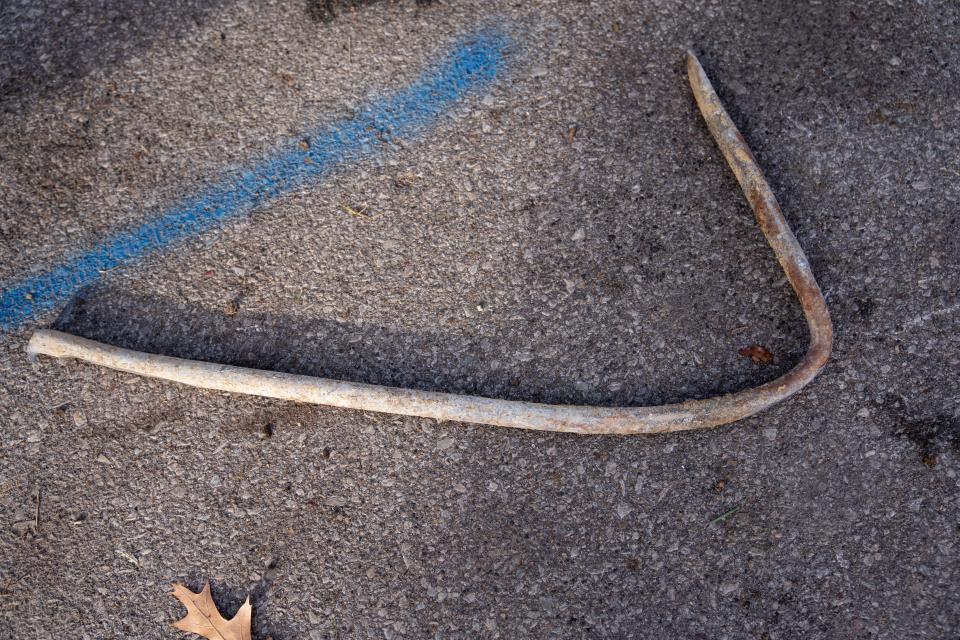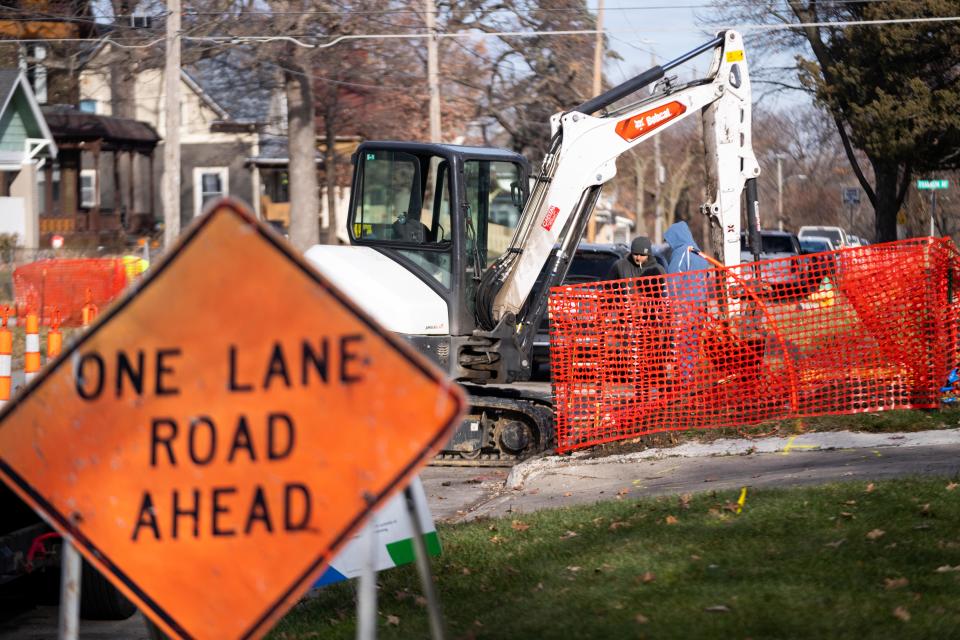Iowa utilities grapple with how to fund up to $1.35 billion in lead water line replacements
Facing a price tag that could amount to $1.35 billion, Iowa water utilities are weighing how they would replace an estimated 96,440 lead service lines across the state under a proposed federal rule change that’s designed to avoid contamination crises like the one that imperiled the 100,000 residents of Flint, Michigan, in 2014.
The U.S. Environmental Protection Agency proposes requiring water utilities to replace 9.2 million lead service lines across the country over the next decade. The Biden administration says the Bipartisan Infrastructure Law provides $15 billion for lead service line replacement, with another $11.7 billion in federal financing available through the Drinking Water State Revolving Loan Fund program.
But that's only a fraction of the up to $80 billion the work could cost, according to an EPA report assessing the nation’s water infrastructure needs.

“Everybody should be able to agree that we don't want lead in our drinking water. It’s really, really important that everyone is protected,” says David Cwiertny, director of the University of Iowa’s Center for Health Effects of Environmental Contamination.
“We all want to see it succeed. But I think we probably all have the same concern about costs,” Cwiertny says.
Lead poisoning puts adults at risk for cardiovascular disease, high blood pressure, decreased kidney function and other health problems. But it’s especially dangerous for children, who can suffer neurological damage, decreased IQ, learning disabilities and behavioral problems, among other issues.
Thousands of Flint residents suffered physical and mental health problems after the bankrupt city in a misdirected cost-saving move switched water sources in 2014, then failed to appropriately treat the more caustic water, resulting in unsafe levels of lead and other contaminants leaching from pipes and into drinking water.
While regular testing for lead shows Des Moines water is safe, water works CEO Ted Corrigan supports removing lead lines, saying they're “a liability as long as they’re there.”
But he and other Iowa utility officials say that along with figuring out how to pay for the work, implementing the proposed rule would bring other challenges. They include locating lead service lines that have been underground for decades; crossing privately owned land to replace lines in consumers’ homes; and getting residents to voluntarily participate.

With 20,000 lead service lines, Des Moines Water Works estimates it would cost $280 million to replace the pipes in its central Iowa service area. To get a better handle on the costs, it is seeking 100 homeowners in Des Moines' River Bend neighborhood who will allow it to replace their lead lines for free under a $1 million pilot project.
Even with extensive outreach to 150 property owners, the utility has reached agreements with only 30.
“We need to figure out how to create interest,” says Corrigan, adding that city leaders may need to consider compelling residents to replace lead lines, if a federal mandate is adopted. “But the biggest challenge is funding.”
'$15 billion isn't nearly enough' to pay for replacements nationally
The Biden administration says lead exposure disproportionately harms impoverished neighborhoods and communities of color. “There is no safe level of exposure to lead, particularly for children, and eliminating lead exposure from the air, water and homes is a crucial component of the Biden-Harris Administration’s historic commitment to advancing environmental justice,” it says in a briefing statement.
UI's Cwiertny is concerned the proposed rule could raise costs for low-income residents. “You don’t want to have unintended consequences,” he says, with utilities forced to increase their rates to complete the work.
And it could be harder for smaller communities to bear the cost.
“We have a lot of water systems with under 10,000 residents that are really going to have to work hard to make the money work,” Cwiertny says.
The Bipartisan Infrastructure Law directs that 49% of the $15 billion for lead line replacements be provided as grants or forgivable loans, and Iowa is expected to follow the federal government's policy. That means 51% of the loans will have to somehow be repaid.
"We don't have any idea where that 51% is going to come," says Corrigan, the Des Moines Water Works CEO.
"We could raise rates. We could look for other grants or other opportunities. We could ask customers who own the lead service lines to pay that 51%," he says, adding that the Iowa Department of Natural Resources has asked utilities to not bill residents for lead line replacement costs.
"There's a big question about the funding," he says, adding, "$15 billion isn’t nearly enough."
Some cities get lucky; others face an enormous task
Corrigan says replacing lead service lines will cost up to $14,000 for each line. The EPA report, assessing costs in 2021, places the expense as low as $5,328 per line and as high as $9,015. The modified federal rule also could require galvanized water lines to be replaced, as well, if they are connected to lead lines.
At $14,000 apiece, replacing Iowa's 96,436 lead service lines would cost $1.35 billion.
In northeast Iowa, Dubuque, the state's oldest city, estimates it has about 5,700 lead service lines, says Water Department Manager Christopher Lester. The city plans to soon begin a $6 million pilot project to replace up to 575 of them, Lester says. The state is providing half the funding.
Younger cities like West Des Moines anticipate few, if any, lead service line replacements, based on its utility's experience replacing large water distribution mains.
"The people who have been here for years haven't come across any lead service lines," says Christina Murphy, West Des Moines Water Works' general manager. "We feel pretty fortunate."
U.S. cities are required to provide a lead service line inventory by October 2024, under a rule change during former President Donald Trump's administration. Should the replacement policy go forward, Corrigan and Lester both say they're concerned about the number of lead lines the cities would have to remediate over a decade.
"That volume of replacement will take a significant effort," Corrigan says.
That's on top of cities' efforts to maintain and upgrade their existing system, Lester says. The EPA infrastructure assessment survey shows Iowa utilities anticipate needing $10.1 billion to upgrade water distribution, treatment and source water development, among other costs.
"Balancing those projects with replacing thousands of service lines is going to be a challenge," Lester says.
Trying to balance water quality, quantity, safety priorities
Corrigan says the pilot program in River Bend, a neighborhood with many century-old homes, is meant to help Des Moines Water Works answer questions about what's needed to make the lead line improvements: How accurate are records of lead line locations? What's needed to make improvements inside a home? How difficult will it be to get participation?
"We're doing it to learn," he says, adding that he's been surprised at the difficulty in getting property owners to participate in the free program. The utility has notified residents with emails, calls and postings on their doors. Staff members also have gone through the area knocking on doors — sometimes with translators ― and reached out to neighborhood groups.
If the rule changes are adopted, the utility may need to ask the city to consider mandating participation. Other cities have discovered that once an ordinance is passed, residents have been cooperative, without the need for implementing penalties, Corrigan says.
"No matter how hard you try, you never get everyone to comply with a voluntary program," he says.

The costs to remove lead service lines come as utilities struggle to find funding to address a host of other issues, including water availability and quality. The EPA also is looking at asking utilities to meet stricter standards for the detection of PFAS — per- and polyfluoroalkyl substances used to make products like nonstick pans, carpets and firefighting foam. They're often referred to as “forever chemicals" because they don't break down and can accumulate over time in human and animal tissues, and they've been tied to cancer, liver damage and other health problems.
"PFAS is a huge discussion among utilities, about how to address it," Murphy says. "All these things cost money, and you're trying to prioritize where you think the best impact on water quality will be."
Removing lead exposure remains a priority, says UI's Cwiertny. Lead poisoning carries a lifetime of impairments.
"They're not reversible," he says. "You can put a price tag on that exposure."
One study says childhood lead exposure costs the U.S. economy $84 billion annually, due to factors like added educational and medical expenses and lost earnings.
"That has to be our message and guiding light — we'll have a more thriving, more equitable society if we can do this," Cwiertny says.
Donnelle Eller covers agriculture, the environment and energy for the Register. Reach her at deller@registermedia.com or 515-284-8457.
This article originally appeared on Des Moines Register: How will Iowa come up with $1.35 billion to remove lead water lines?

